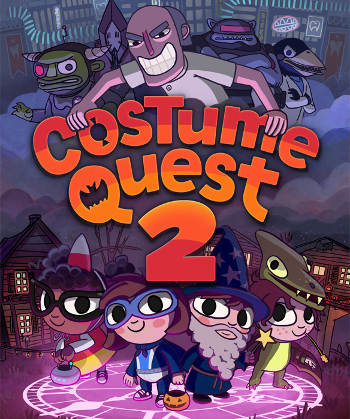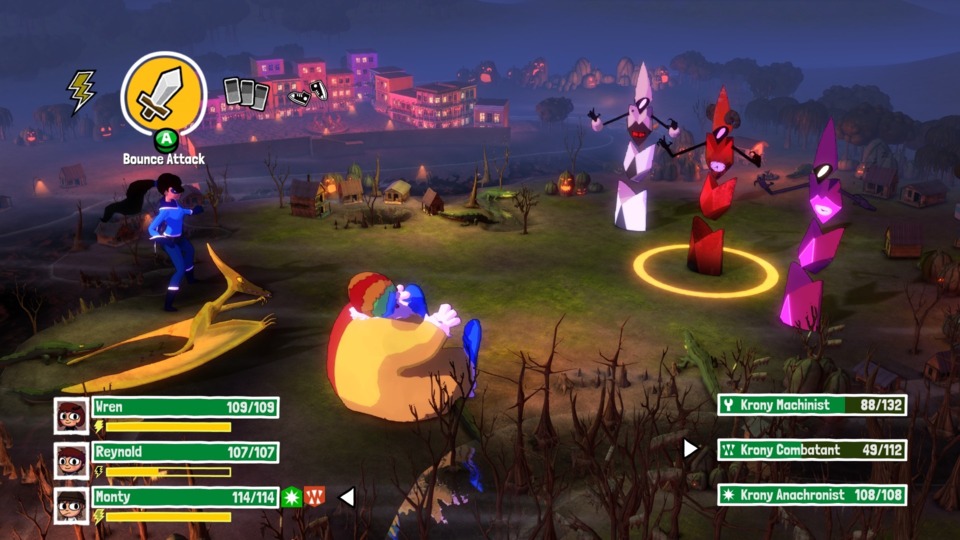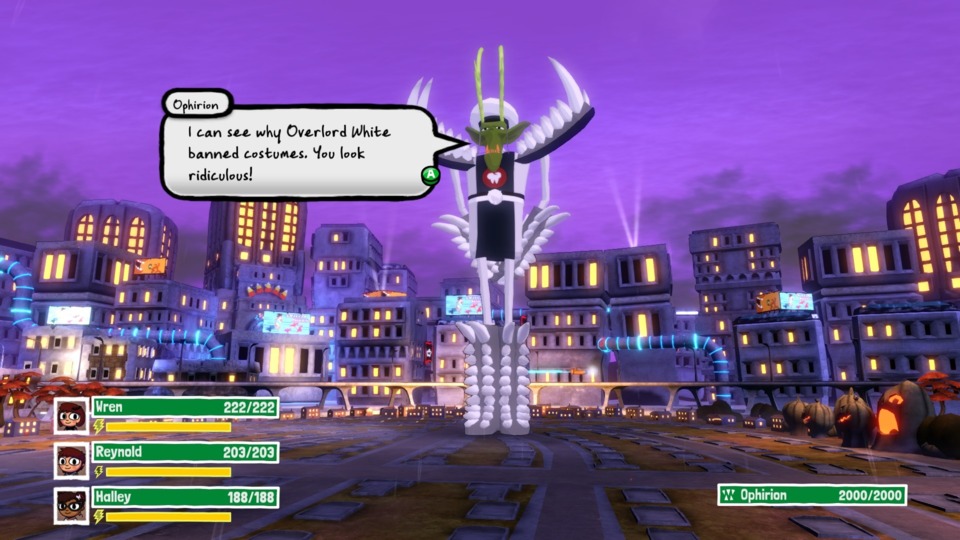Indie Game of the Week 358: Costume Quest 2
By Mento 0 Comments

I wonder how common it is to have developers where you're a fan of their whole style and maybe a few of the people who work there, but mostly only just tolerate the games they put out. Like you appreciate their moxie, or their adherence to a perhaps archaic way of doing things that appeals to your sense of nostalgia, or they're someone you followed over from game journalism and are rooting for them in the next leg of their careers. I have two myself: Supergiant Games, which no longer needs any grassroots support from me to bat for them after the unbelievable hit that was Hades, and Tim Schafer and co.'s Double Fine. Everything I've played of Double Fine's, from Psychonauts to... uh Psychonauts 2, has been good if not great but they're able to bump up my appraisal of those games due to the comedic style they exhibit, much like Schafer's earlier work with the LucasFilm graphic adventure games for which he became a known industry figure. Some DF games I didn't care for at all—Brutal Legend's affectionately silly metal leanings and Jack Black's full commitment to his role really carried that playthrough whenever the tepid RTS sequences threatened to derail it—but I've always mostly liked most of them. One game that I thought could've been a lot better, to the extent that a sequel that built on and fleshed out its mechanics had a real shot of being a truly great DF game, was the kid-friendly spook 'em up turn-based RPG Costume Quest. The sequel Costume Quest 2, which is this IGotW if that wasn't clear from the title and image, doesn't quite fulfill the concept's potential either, alas.
Costume Quest 2 is set directly after the story of the first and works to resolve its cliffhanger conclusion as twins Wren and Reynolds, along with their neighborhood friends Everett and Lucy, pass through a mystical portal on the way to defeating their nemesis, the killjoy dentist Dr. Orel White whose hatred of candy and Halloween night pushed him into unsealing and controlling a realm full of goblin-like monsters to build his own sugar-free dystopia. The sequel pulls a BTTF2 and sees the pair of siblings appear in a future some twenty years removed from the present after Dr. White has already built his grim Biff Tannen hell world. The adult Everett and Lucy, now married with a kid the twins' age, inform the duo that they can still save the present by going twenty years back (or forty years from their perspective) to before a time-travelling Dr. White originally snatched the idol that kept the monsters safely locked away. It's an excuse for some time-hopping hi-jinks, not too dissimilar to the middle act of Schafer's own Day of the Tentacle, as the pair along with a rotating third member run into any number of excuses to fall into the original game's pattern of having a number of houses to trick or treat and either receiving candy (which doubles as currency, as well as a quick pick-me-up for emergencies) or being forced into a fight.

Most of the gameplay loop involves running around these new neighborhood equivalents, from the town's Louisianan past as a bayou connected to a New Orleans-like "French Quarter" to the future dystopia with its goblin-run metropolis, all the while collecting candy while assembling new costumes and completing side-quests for useful (and often progress-mandatory) items. The costumes confer new "jobs" for the combat, in which each has a particular elemental type they're strong and weak against (which affects both incoming and outgoing damage), a unique special ability that requires you to max out a gauge first, and their own ratio of health and power increases. Beyond the one special, though, they all fight more or less the same with a few minor differences: for instance, the wizard (which takes a penalty to health for more power) has a normal attack that spreads a small amount of damage to the other enemies, while the Wolfman's attacks leave behind a damage-over-time bleeding effect. What counts most are the elemental superiority/inferiority traits, as it'll help immensely to ensure you're always able to do more damage and take less from the local enemies. (Unfortunately, you only get one costume—the founding father—that is effective against "tech" enemies, making it the only compulsory one.) The game, like its predecessor, also employs a "timed hits" system that further boosts or mitigates damage with accurate timing, and later provides a means of countering attacks albeit with some risk: you have to start charging the counter early, which means making a 1 in 3 guess as to which of your party members is about to receive the attack (it's sometimes obvious, but not always).
Outside of combat, many of the costumes have their own traversal ability attached, most of which become essential for progress at one point or another. In fact, there's very few truly optional costumes in the game for this reason. Annoyingly, you have to switch your main character to this costume whenever you want to use this traversal skill and then remember to switch back if you already have a party dynamic planned out. Given Psychonauts 2 also had a lot of this constant menu tinkering with its powers, it's evidently not an issue DF has found a way around in the years between the two. Despite that, I found the exploration to be the game's highlight, including the many ways it would hide chests and other valuables around the vicinity and task you to uncover them while also being chill enough to sell you maps that give you a firm idea of how many secrets there are to be found (as well as which houses you've yet to "trick or treat", crossing them off afterwards Silent Hill style). The writing and presentation in general is still pretty good, albeit aiming for a younger audience. Of course, you could say that about every facet of the game too: much of the very simple gameplay and lack of features or variety definitely hearkens back to one Final Fantasy Mystic Quest for SNES, a game designed from the bottom-up to be an "entry-level RPG" for those unfamiliar with that subgenre.

That's really where I have an issue with the two Costume Quest games, which are fairly interchangeable if we're talking features and advancements. Anyone going in expecting the bar-raising of a Trails in the Sky SC or Baldur's Gate 2, where character levels have a higher starting point and the game feels secure enough to start rolling out the really heavy stuff for you to contend with, isn't going to get that here. It's as much of a softball as the first, albeit one where instead of a wider range of tactical considerations leading the difficulty curve it's instead ever more damage sponge-y opponents that inevitably do enough serious harm to your party that you have to pause your exploration momentum after every fight to go find one of the healing fountains to refresh—an inconvenience that makes little sense given the game's lack of random encounters (in the sense you always know one is coming, either because the enemies are wandering the overworld or the door you're about to knock on may have a fight behind it). It's a slog, in so many words, and the appealing wrappings around it can only do so much to keep you engaged for the long haul. Mercifully, it's not too long at around a sub-10 hour playthrough, so it at least earns my respect for not stretching things out to eternity like a few other turn-based RPG throwbacks out there. Much like Sonic fans and their own eternal struggle, I'll keep on buying Double Fine games enjoying their style while hoping that they're someday able to nail the gameplay half as well.
Rating: 3 out of 5.
| < Back to 357: The Procession to Calvary | 001-100 | 101-200 | 201-300 | > Forward to 359: Depths of Sanity |
